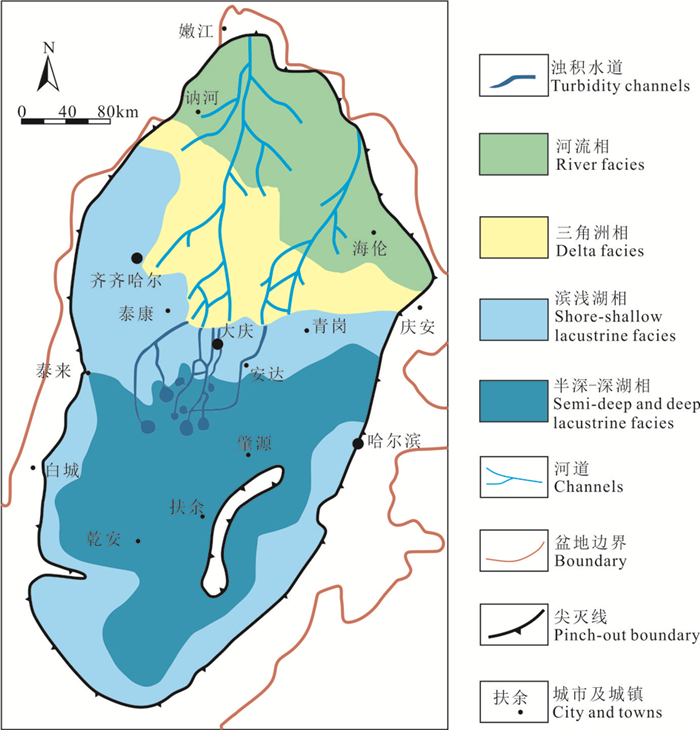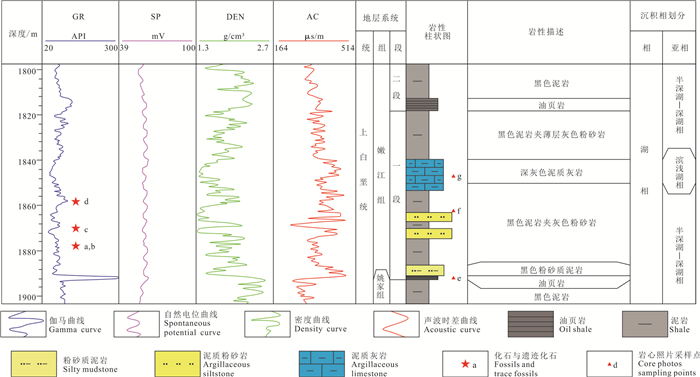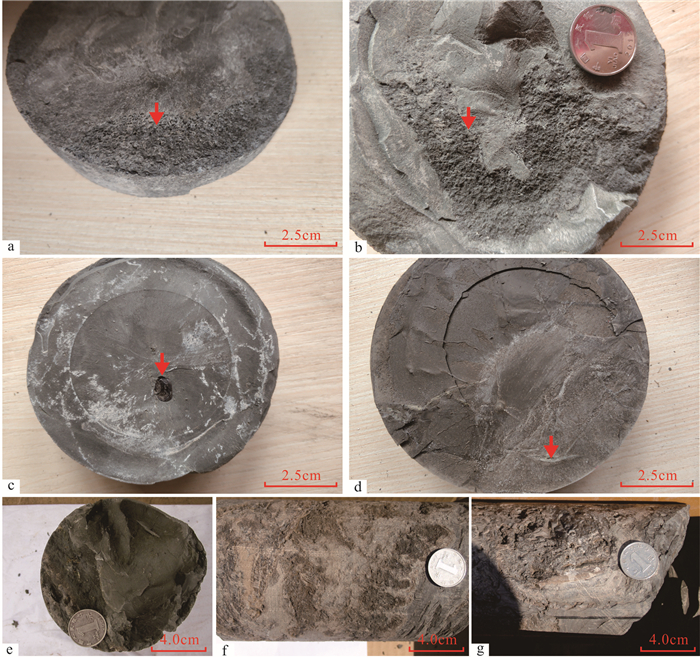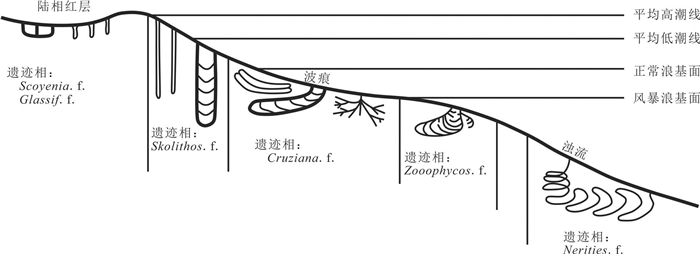Nenjiang Formation 1 member Ichnocoenosis and its deposit environment of Upper Cretaceous from Yaonan 5 well, Songliao Basin
-
摘要:研究目的
松辽盆地上白垩统嫩江组中含有丰富的遗迹化石,但相关研究主要集中于松辽盆地北部。通过鉴定遗迹化石还原松辽盆地南部嫩江组一段沉积环境,为该地区后续遗迹化石研究提供证据支持。
研究方法通过观察腰南5井嫩江组一段岩心,发现了Chondrites及Planolites等共计2属,2种遗迹化石,建立了Chondrites-Planolites遗迹化石组合;结合遗迹化石围岩岩性、潜穴规模、测井曲线记录对造迹生物生存习性进行分析;通过腰南5井采样,分析样品中铀、钍、钒、镍与钴含量,使用铀/钍、钒(/钒+镍)与镍/钴等手段对嫩一段遗迹化石保存层位的古氧相进行还原。
研究结果研究认为Chondrites-Planolites遗迹化石组合形成于水动力较小的深水环境;古氧相数据分析表明,腰南5井嫩一段泥岩样品铀/钍指示常氧环境,钒(/钒+镍)与镍/钴指示贫氧-缺氧环境。
结论腰南5井嫩一段遗迹化石组合保存于泥岩且潜穴直径小,遗迹化石丰度低,表明水体含氧量低。结合古氧相数据和测井曲线分析,认为造迹生物的生活环境为水动力较弱且水体氧含量低的半深湖相环境。
创新点: 鉴定了腰南5井嫩江组一段的遗迹化石种类,建立了Chondrites-Planolites遗迹化石组合;根据遗迹化石组合、古氧相数据和测井曲线特征还原了松辽盆地南部白垩统嫩江组一段的沉积环境。
Abstract:This paper is the result of oil and gas exploration engineering.
ObjectiveAbundant trace fossils were preserved in Upper Cretaceous strata in Songliao Basin, but related studies mainly focus on the northern part of the Songliao Basin. The sedimentary environment of section 1 of the Nenjiang Formation was restored by trace fossils identification in the southern part of the Songliao Basin, and this paper will provide evidence to support subsequent trace fossil studies in this area.
MethodsAccording toobserve wells of Yaonan 5 drill core of section 1 of the Nenjiang Formation, we identified 2 ichnogenus and 2 ichnospecies including Chondrites and Planolites, and established Chondrites-Planolites ichnocoenosis. Combining with ichnofossils surrounding rock, burrow scale, record of well logging curve to analyse trace maker habit; According well of Yaonan 5 sampling, measured sample contents of Uranium, Thorium, Vanadium, Nickel and Cobalt; Using U/Th, V/(V + Ni) and Ni/Co methods to restore trace fossil preservation strata paleo-oxygen facies of section 1 of the Nenjiang Formation.
ResultsThis study suggests that Chondrites-Planolites ichnocoenosis were formed in deep water environment with weak water energy; Paleo-oxigenation facies data analysis suggests that method of U/Th indicated oxic environment, methods ofV/(V + Ni) and Ni/Co indicated dysaerobic-anaerobic environment.
ConclusionsThe trace fossils were preserved in mudstone in well Yaonan 5 with small burrow diameter scale and low abundance, indicating the water was anoxic. Combined with the paleooxygen facies data and logging curve analysis, considering that tracemaker were living in semi-deep lake which with low energy and poor oxygen content.
-
1. 引言
松辽盆地是世界上规模最大的陆相含油气盆地之一,位于该盆地内部的大庆油田长期处于我国第一大油田的位置,为我国的油气生产做出了巨大贡献。由于松辽盆地规模大,沉积环境类型全,因此一直是陆相沉积学和层序地层学研究的热点(葛新,2010)。在近几年针对松辽盆地的沉积学研究中,对油气藏的特征研究较为集中(蒙启安等,2014;修立君等,2016;李瑞磊等,2017;刘学珍等,2019;任颖惠等,2019;张瀛涵等,2019;苗长盛等,2020;孙立东等,2020;周路路等,2021)。松辽盆地除富含油气外,在上白垩统中有丰富的遗迹化石。遗迹化石对古地理还原具有自身独特优势,但有关松辽盆地遗迹化石的研究较为有限(石和,1996;郑玉龙等, 2000, 2005),关于嫩江组相关的遗迹化石分析更为稀缺(郑玉龙等,2005)。因此本文通过前人所得出认识的基础上,结合钻井岩心观察、遗迹化石属种鉴定、测井曲线分析、古氧相分析以及古遗迹学研究中取得的新认识,鉴别腰南5井(图 1a,b)嫩江组一段岩心中保存的遗迹化石,建立遗迹化石组合,通过微量元素地球化学手段还原嫩一段水体古氧相,恢复该组古地貌,探讨该段造迹生物的生存环境,验证前人在嫩一段取得的认识,同时为后续松辽盆地古地理学和古遗迹学的相关研究提供依据。
![]() 图 1 研究区域示意图(据郑玉龙等,2005修改)Figure 1. Locaion of study area (modified from Zheng Yulong et al., 2005)
图 1 研究区域示意图(据郑玉龙等,2005修改)Figure 1. Locaion of study area (modified from Zheng Yulong et al., 2005)2. 研究区地质背景
白垩系是松辽盆地主要沉积地层,分布范围广、沉积厚度大,分布广泛(葛新,2000;冯志强等,2012;李翔,2015)。白垩系以登娄库组顶部为界,分为上白垩统和下白垩统。其中上白垩统由上自下分别为嫩江组、姚家组和青山口组(黄清华等,2011)。嫩江组共分五段,地层自下向上岩性由细变粗。位于嫩江组底部的嫩江组一段以灰黑、深灰色泥岩为主,夹薄层油页岩、灰绿色粉砂质泥岩和粉砂岩,自北向南为河道-三角洲-滨浅湖-半深湖相沉积(图 2)。本次观察的腰南5井嫩一段岩心岩性以黑色泥岩为主,夹灰色粉砂岩。与嫩江组二段底部的油页岩呈整合接触(图 3,图 4)。
![]() 图 2 松辽盆地嫩一段沉积相分布示意图(据冯志强等,2012修改)Figure 2. Sedimentary facies distribution of K2n1 in the Songliao Basin (modified from Feng Zhiqiang et al., 2012)
图 2 松辽盆地嫩一段沉积相分布示意图(据冯志强等,2012修改)Figure 2. Sedimentary facies distribution of K2n1 in the Songliao Basin (modified from Feng Zhiqiang et al., 2012)![]() 图 4 腰南5井嫩江组一段化石、遗迹化石及岩心照片a—Chondrites,1873.08 m;b—Chondrites,1873.19 m;c—双壳类生物化石,1870.44 m;d—Planolites beverleyensis,1858.61m;e—油页岩岩心,1899.79 m;f—粉砂岩岩心,1863.52 m;g—泥质灰岩岩心,1856.29 mFigure 4. Nenjiang formation 1 member photographs of fossils, trace fossils and rock cores of Upper Cretaceous from Yaonan 5 wella-Chondrites, 1873.08 m; b-Chondrites, 1873.19 m; c- Bivalvia fossil, 1870.44 m; d-Planolites beverleyensis, 1858.61m; e- Oil shale core, 1899.79 m; f-Argillaceous siltstone core, 1863.52 m; g-Argillaceouslimestone core, 1856.29 m
图 4 腰南5井嫩江组一段化石、遗迹化石及岩心照片a—Chondrites,1873.08 m;b—Chondrites,1873.19 m;c—双壳类生物化石,1870.44 m;d—Planolites beverleyensis,1858.61m;e—油页岩岩心,1899.79 m;f—粉砂岩岩心,1863.52 m;g—泥质灰岩岩心,1856.29 mFigure 4. Nenjiang formation 1 member photographs of fossils, trace fossils and rock cores of Upper Cretaceous from Yaonan 5 wella-Chondrites, 1873.08 m; b-Chondrites, 1873.19 m; c- Bivalvia fossil, 1870.44 m; d-Planolites beverleyensis, 1858.61m; e- Oil shale core, 1899.79 m; f-Argillaceous siltstone core, 1863.52 m; g-Argillaceouslimestone core, 1856.29 m3. 遗迹化石组合
由于嫩江组沉积相种类多,且在该时期的沉积环境适宜生物生存,因此在嫩江组中存在多种遗迹相(郑玉龙等,2005)。Seilacher(1967)将遗迹相划分为Scoyenia,Skolithos,Cruziana,Zoophycos以及Nereties等5个遗迹相(图 5),5种遗迹相分别代表不同的古环境(Seilacher,1967;杨式溥等,2004)。腰南5井嫩一段岩心中发现的遗迹化石为Chondrites ichnoisp.和Planolites beverleyensis。按照Seilacher的遗迹化石保存分类划分,其形式以半浮雕形式保存在黑色泥岩中。
![]() 图 5 遗迹相及其环境分布模式图(据Seilacher,1967修改)Figure 5. Ichnofacies and its environmental distribution pattern (modified from Seilacher, 1967)
图 5 遗迹相及其环境分布模式图(据Seilacher,1967修改)Figure 5. Ichnofacies and its environmental distribution pattern (modified from Seilacher, 1967)3.1 遗迹化石描述
3.1.1 丛藻迹属Chondrites Sternberg,1833;丛藻迹未定种Chondrites ichnoisp.
该种遗迹化石潜穴密集,潜穴以倾斜或垂直于地层的形式保存于嫩一段黑色泥岩中(图 4a,b),可见分枝潜穴,潜穴分枝为二分,无衬里,分枝潜穴直径范围为0.5~1.0 mm。由于化石几乎被围岩包裹,仅可见岩心底部、侧部分支潜穴,无法观察更多细节,因此不定遗迹种。在该套地层中向上可见双壳类生物化石(图 4c)、Planolites(图 4d)与其共存。该种遗迹化石被认为存在于深水环境中,为贫氧-缺氧环境种的化石,但随着遗迹化石的深入研究,认为该种遗迹化石在古生代可存在于常氧、贫氧和缺氧等多种环境;而在中生代该种遗迹化石由于海生迹爆发导致其生存坏境发生改变,进而成为深水环境的指向性化石(Bromley and Ekdale, 1984;姜涛等,2018;荆锡贵,2018)。本次在嫩一段发现Chondrites,其潜穴密集,直径均在1 mm左右。Savrda and Bottjer(1986)认为,Chondrites的潜穴直径反映了其造迹生物活动时期水体氧含量,结合保存环境,推测该种遗迹化石造迹生物生活环境为环境较为恶劣且水体氧含量较低的深水地区。层位:嫩江组一段,1873.08 m;嫩江组一段,1873.19 m。
3.1.2 漫游记属Planolites Nicholson,1873;贝弗利漫游记Planolites beverleyensis,Billing,1862
该遗迹化石略微弯曲,保存于岩心底部,遗迹化石较围岩凸出约1.0 mm,潜穴颜色略浅于围岩。该种遗迹长约2.0 cm,潜穴直径约1.5 mm,潜穴较为光滑,可见分枝呈“Y”型保存于黑灰色泥岩中(图 4c)。杨式溥等(2004)指出,Planolites系食沉积物动物形成的觅食构造,且该种遗迹化石能适应各种深度环境。本次发现的Planolites遗迹化石规模较小,且与Chondrites遗迹化石在黑色泥岩中共生,同样表明在该时期造迹生物生存于水体氧含量较低的深水环境中。层位:嫩江组一段,1858.61 m。
3.2 遗迹化石组合
Chondrites-Planolites遗迹化石组合保存于嫩一段的黑色泥岩中,由Chondrites isp.以及Planolites beverleyensis等2种觅食迹遗迹化石组成。构成遗迹化石组合的2种遗迹化石潜穴规模较小,且在嫩江组一段中遗迹化石丰度低,表明造迹生物生存环境较为恶劣,适应环境的造迹生物种类少。Chondrites-Planolites遗迹化石组合的出现,指示了水体能量弱且深度较深的半深湖环境。
3.3 遗迹化石组合测井曲线特征分析
通过岩心观察鉴定遗迹化石外,结合腰南5井嫩江组一段中相应深度的单井GR曲线形态,认为在该井嫩一段除存在箱型曲线外,同时存在漏斗形、钟形曲线。且在该井中的曲线组合存在漏斗形-钟形,钟形-箱型曲线组合(图 3)。遗迹化石和双壳类化石出现层位均对应箱型曲线,表明在垂向上粒度变化较小,遗迹化石及实体化石均存在于水动力条件相对稳定的环境;而Chondrites-Planolites遗迹化石组合在该种测井曲线特征的环境下出现,结合沉积物粒度进行分析,从另一方面指示了遗迹化石的造迹生物存在于深水环境中。
4. 嫩一段泥岩古氧相分析
Chondrites作为一种穿相遗迹化石,在造迹生物生活环境的古氧相研究中一直存在较大争议。国外学者普遍认为,Chondrites形成于缺氧相环境下(Bromley and Ekdale, 1984,1986;马会珍等,2010);而杨式溥等(2004)认为,Chondrites在地层中的出现,代表该地层为缺氧相;马会珍等(2010)认为,只有寄主岩系为深灰色—黑色,为灰岩、泥灰岩,潜穴直径小于1 mm、无其他遗迹化石共生时,Chondrites才是贫氧环境标志性遗迹化石;而荆锡贵(2018)在针对龙门山泥盆系中存在的Chondrites进行相关研究时,认为Chondrites浅穴直径大小与常氧环境下水体的氧含量并无直接关系,更可能由沉积物粒径、水体氧含量以及造迹生物种类等共同作用有关;由于中生代存在一部分遗迹化石的造迹生物生存环境有别于古生代(如Zoophycos等)(张立军和龚一鸣,2013;Li et al.,2017;荆锡贵等,2018),在分析嫩一段遗迹化石的古氧相时,不能直接使用前人在相关研究中取得的认识。因此,针对腰南5井嫩一段岩心采集10个样品进行微量元素分析。样品分别为底部油页岩样品1个、Chondrites遗迹化石层位正负1 m内泥岩岩心样品4个,Planolites遗迹化石层位正负1 m内泥岩岩心样品4个,嫩一段上部泥岩取样1个,送至四川冶金地质岩矿测试中心完成测试,测试依据为《岩石矿物分析(第二分册)》(DZG20-02)中相关要求。
微量元素分析发现,根据施春华等(2004)的分类(表 1),嫩江组一段泥岩U/Th平均值为0.36,属常氧相;V/(V+Ni)平均值为0.78,属缺氧相;V/Cr平均值为2.16,属贫氧相(表 2)。除U/Th数值偏小外,V/(V+Ni)、V/Cr反映的古氧相与深水沉积环境较为相符。
表 1 嫩江组一段古氧相地球化学指标对比(据施春华等,2004)Table 1. Geochemical indexes of paleo-oxygenation facies of K2n1(modified from Shi Chunhua et al., 2004) 表 2 腰南5井嫩一段泥岩地球化学数据分析Table 2. Shale paleo-oxygenation facies geochemical data analysis of K2n1 from well Yaonan 5
表 2 腰南5井嫩一段泥岩地球化学数据分析Table 2. Shale paleo-oxygenation facies geochemical data analysis of K2n1 from well Yaonan 5
5. 嫩一段遗迹化石组合及沉积环境、意义
通过对前人在嫩江组所做工作,结合腰南5井岩心观察、遗迹化石属种鉴定、遗迹化石造迹生物生存环境分析,认为存在于嫩江组一段的Chondrites-Planolites遗迹化石组合,其造迹生物生存环境为深水环境。地球化学指标V/(V+Ni)、V/Cr指向的古氧相同样也符合深水沉积的特征。而遗迹化石的U/Th比值实际认识发生冲突,需要在后期的相关工作中做进一步研究。通过沉积相、遗迹化石组合、测井曲线以及微量元素地球化学恢复古氧相等手段综合分析,认为腰南5井在嫩一段主要发育水动力强度弱、水体氧含量较低的半深湖相沉积。
6. 结论
(1)通过岩心观察、遗迹化石鉴定认为,嫩江组一段的黑色泥岩中保存有Chondrites isp.,Planolites beverleyensis等2种遗迹化石;由这2种遗迹化石构成的Chondrites-Planolites遗迹化石组合,反映了水动力作用较弱,沉积稳定且水体氧含量低的半深湖沉积环境。
(2)嫩江组一段水体古氧相通过U/Th、V/(V+Ni)与V/Cr等手段进行恢复,与遗迹化石反映的沉积环境较为符合。U/Th平均比值为0.36,指示常氧相;V/(V+Ni)与V/Cr平均比值分别为0.78和2.16,分别指示缺氧相与贫氧相环境,与沉积环境较为一致。
(3)由于嫩江组一段为深水环境沉积,在该段存在大段黑色泥岩,且处于氧气较低的环境,因此富含有机质,具有一定生烃条件。若在找到良好圈闭情况下,可作为生油层。
-
图 1 研究区域示意图(据郑玉龙等,2005修改)
Figure 1. Locaion of study area (modified from Zheng Yulong et al., 2005)
图 2 松辽盆地嫩一段沉积相分布示意图(据冯志强等,2012修改)
Figure 2. Sedimentary facies distribution of K2n1 in the Songliao Basin (modified from Feng Zhiqiang et al., 2012)
图 4 腰南5井嫩江组一段化石、遗迹化石及岩心照片
a—Chondrites,1873.08 m;b—Chondrites,1873.19 m;c—双壳类生物化石,1870.44 m;d—Planolites beverleyensis,1858.61m;e—油页岩岩心,1899.79 m;f—粉砂岩岩心,1863.52 m;g—泥质灰岩岩心,1856.29 m
Figure 4. Nenjiang formation 1 member photographs of fossils, trace fossils and rock cores of Upper Cretaceous from Yaonan 5 well
a-Chondrites, 1873.08 m; b-Chondrites, 1873.19 m; c- Bivalvia fossil, 1870.44 m; d-Planolites beverleyensis, 1858.61m; e- Oil shale core, 1899.79 m; f-Argillaceous siltstone core, 1863.52 m; g-Argillaceouslimestone core, 1856.29 m
图 5 遗迹相及其环境分布模式图(据Seilacher,1967修改)
Figure 5. Ichnofacies and its environmental distribution pattern (modified from Seilacher, 1967)
表 1 嫩江组一段古氧相地球化学指标对比(据施春华等,2004)
Table 1 Geochemical indexes of paleo-oxygenation facies of K2n1(modified from Shi Chunhua et al., 2004)

表 2 腰南5井嫩一段泥岩地球化学数据分析
Table 2 Shale paleo-oxygenation facies geochemical data analysis of K2n1 from well Yaonan 5

-
Bromley R G, Ekdale A A. 1984. Chondrites: A trace fossil indicator of anoxia in sediments[J]. Science, 224(4651): 872-874. doi: 10.1126/science.224.4651.872
Bromley R G, Ekdale A A, 1986. Composite ichnofabrics and tiering of burrows[J]. Geological Magazine, 123(1): 59-65. doi: 10.1017/S0016756800026534
Feng Zhiqiang, Zhang Shun, Fu Xiuli. 2012. Depositional evolution and accumulation response of Yaojia-Nenjiang Formation in Songliao Basin[J]. Earth Science Frontiers, 19(1): 78-87(in Chinese with English abstract).
Ge Xin. 2010. Study on Sequence Stratigraphy and Depositional Systems of Yaojia Formation-Nenjiang1 Member in Daqing Placanticline[D]. Beijing: China University of Geosciences (Beijing), 1-29(in Chinese with English abstract).
Huang Qinghua, Wu Huaichun, Wan Xiaoqiao, He Huaiyu, Deng Chenglong. 2011. New progress of integrated chronostratigraphy of the Cretaceous in Songliao Basin[J]. Journal of Stratigraphy, 35(3): 250-257(in Chinese with English abstract).
Jiang Tao, Li Fengjie, Yang Xiaoqi, Jing Xigui, Cheng Xiaoyu Zhang Hao, Shen Fan. 2018. Ichnogenera of Chondrites of the Early-middle Devonian in Longmenshan area of China and its environmental significances[J]. Journal of Chengdu University of Technology (Science & Technology Edition), 45(3): 334-343 (in Chinese with English abstract).
Jing Xigui. 2018. The study of Devonian Trace Fossils and its Environmental Significance From Longmenshan Area, Northern Sichuan[D]. Chengdu: Chengdu University of Technology, 1-50 (in Chinese with English abstract).
Jing Xigui, Li Fengjie, Cheng Xiaoyu, Yang Xiaoqi, Zhang Hao, Shen Fan. 2018. Trace fossils of hybrid facies from Early-Middle Devonian strata in Longmenshan area, Sichuan Province[J]. Geology in China, 45(2): 377-391 (in Chinese with English abstract).
Li Fengjie, Zhang Hao, Jing Xigui, Cheng Xiaoyu. 2017. Paleoenvironmental analysis of the ichnogenus Zoophycos in the Lower Devonian tempestite sediments of the Longmenshan area, Sichuan, China[J]. Palaeogeography Palaeoclimatology Palaeoecology, 465(Part A): 156-167.
Li Ruilei, Yang Qinlin, Tian Jianhua, Zhu Jianfeng. 2017. Tight sandstone gas prediction in the Longfeng Mountain gas field of Songliao Basin, China[J]. Geophysical Prospecting for Petroleum, 56(6): 104-111(in Chinese with English abstract).
Li Xiang. 2015. The Distribution Characteristics and Resources Potential Assessment of Oil Shale in the Upper Cretaceous of Songliao Basin[D]. Changchun: Jilin University, 1-72 (in Chinese with English abstract).
Liu Xuezhen, Wang Xueyan, Zhong Anning, Yang Yingchun, Zhang Shixiang, Zhou Xiang. 2019. Characteristic of provenance and their control over sand bodies in Shahezi Formation of Xujiaweizi fault depression, Songliao Basin[J]. Natural Gas Geoscience, 30(11): 1551-1559(in Chinese with English abstract).
Ma Huizhen, Zhang Lijun, Gong Yiming. 2010. Chondrites from the Devonian neritic Cruziana Ichnofacies as indicators of Palaeo-oxygenation facies in South China[J]. Advances in Earth Science, 25(9): 966-973 (in Chinese with English abstract).
Meng Qi'an, Bai Xuefeng, Liang Jiangping, Tang Zhenguo, Xue Tao, Peng Jianliang. 2014. Fuyu tight oil characteristics and exploration countermeasures in North Songliao Basin[J]. Petroleum Geology & Oilfield Development in Daqing, 33(5): 23-29(in Chinese with English abstract).
Miao Changsheng, Xu Wen, Liu Yuhu, Xie Rongxiang. 2020. Characteristics of volcanic reservoirs in Southern Songliao Basin[J]. Journal of Jilin University (Earth Science Edition), 50(2): 635-643(in Chinese with English abstract).
Ren Yinghui, Yan Mingqi, Li Wenxu, Luo Danting. 2019. Study on shale characteristics and reservoir accumulation period in Qijia-Gulong Depression, Songliao Basin, China[J]. Journal of Chengdu University of Technology (Science & Technology Edition), 46(6): 660-666(in Chinese with English abstract).
Savrda C E, Bottjer D J. 1986. Trace-fossil model for reconstruction of paleo-oxygenation in bottomwaters[J]. Geology, 14(1): 3-6. doi: 10.1130/0091-7613(1986)14<3:TMFROP>2.0.CO;2
Seilacher A. 1967. Bathymetry of trace fossils[J]. Marine Geology, 5(5): 413-428.
Shi Chunhua, Hu Ruizhong, Yan Jiaxin. 2004. Sedimentary geochemistry of the Qixia Formation and its environmental implication[J]. Bulletin of Mineralogy Petrology and Geochemistry, 23(2): 144-148 (in Chinese with English abstract).
Shi He. 1996. Taphonomy, Ichnofacies and sedimentary environment in the Members 3 and 4 of the Quantou Formation, northeastern part of Songliao Basin[J]. Journal of Mineralogy and Petrology, 16(2): 70-76(in Chinese with English abstract).
Sun Lidong, Sun Guoqing, Yang Buzeng, Zhao Fuhai, Li Jing, Li Guangwei, Xu Yan. 2020. Hydrocarbon accumulation conditions of the buried hills in the central paleo-uplift belt of the northern Songliao Basin[J]. Natural Gas Industry, 40(3): 23-29(in Chinese with English abstract).
Xiu Lijun, Shao Mingli, Tang Huafeng, Dong Changchun, Gao Youfeng. 2016. Types and characteristics of volcanic reservoir pore-fracture units of Cretaceous Yingcheng Formation in Songliao Basin, NE China[J]. Journal of Jilin University (Earth Science Edition), 46(1): 11-22(in Chinese with English abstract).
Yang Shipu, Zhang Jianping, Yang Meifang. 2004. Trace Fossils of China[M]. Beijing: Science Press, 1-353 (in Chinese with English abstract).
Zhang Lijun, Gong Yiming. 2013. Ichnocoenosis of the Lower Devonian Pingyipu Formation, Longmen mountain, Sichuan[J]. Acta Palaeontologica Sinica, 52(1): 86-95 (in Chinese with English abstract).
Zhang Yinghan, Li Zhuo, Liu Dongdong, Gao Fenglin, Jiang Zhenxue, Liang Zhikai, Yang Dongxu, Yu Hailong. 2019. Lithofacies characteristics and impact on pore structure of the Shahezi Formation shale, Changling Fault Depression, Songliao Basin[J]. Petroleum Geology & Experiment, 41(1): 142-148, 156(in Chinese with English abstract).
Zheng Yulong, Chen Chunrui, Huang Qinghua. 2000. The ichnite fossil of Yaojia Member in Songliao Basin and its environmental dignificance[J]. Petroleum Geology & Oilfield Deuelopment In Daqing, 19(6): 12-14, 53(in Chinese with English abstract).
Zheng Yulong, Chen Chunrui, Ren Linwei. 2005. Continental trace fossils and their sedimentary environments of the Upper Cretaceous in Songliao Basin[J]. Journal of Palaeogeography, 7(3): 337-346(in Chinese with English abstract).
Zhou Lulu, Liu Jungang, Shu Guangqiang, Liu Zhiwei, Chen Zhang, Wang Shuangtao, Tang Gang, Li Qinguo. 2021. Research on flow units of ultralow permeability oil-gas reservoirs in Sheng 554 fault block of Sanzhao depression, northern Songliao Basin [J]. Geology in China, 48(3): 807-819(in Chinese with English abstract).
冯志强, 张顺, 付秀丽. 2012. 松辽盆地姚家组—嫩江组沉积演化与成藏响应[J]. 地学前缘, 19(1): 78-87. 葛新. 2010. 大庆长垣姚家组-嫩江组一段层序地层及沉积体系研究[D]. 北京: 中国地质大学(北京), 1-29. 黄清华, 吴怀春, 万晓樵, 贺怀宇, 邓成龙. 2011. 松辽盆地白垩系综合年代地层学研究新进展[J]. 地层学杂志, 35(3): 250-257. 姜涛, 李凤杰, 杨晓琪, 荆锡贵, 成晓雨, 张昊, 沈凡. 2018. 龙门山早—中泥盆世Chondrites类型及其环境意义[J]. 成都理工大学学报(自然科学版), 45(3): 334-343. 荆锡贵. 2018. 龙门山地区北川泥盆系遗迹化石及其环境意义研究[D]. 成都: 成都理工大学, 1-50. 荆锡贵, 李凤杰, 成晓雨, 杨晓琪, 张昊, 沈凡. 2018. 四川龙门山地区早-中泥盆世混迹相遗迹化石及其环境分析[J]. 中国地质, 45(2): 377-391. doi: 10.12029/gc20180212 李瑞磊, 杨勤林, 田建华, 朱建峰. 2017. 松辽盆地龙凤山气田致密砂岩含气性预测研究[J]. 石油物探, 56(6): 104-111. 李翔. 2015. 松辽盆地上白垩统油页岩展布规律及潜力预测[D]. 长春: 吉林大学, 1-72. 刘学珍, 王雪艳, 钟安宁, 杨迎春, 张世祥, 周翔. 2019. 松辽盆地徐家围子断陷沙河子组物源特征及对储集砂体的控制作用[J]. 天然气地球科学, 30(11): 1551-1559. 马会珍, 张立军, 龚一鸣. 2010. 华南泥盆纪Chondrites的特征及其对古氧相的示踪[J]. 地球科学进展, 25(9): 966-973. 蒙启安, 白雪峰, 梁江平, 唐振国, 薛涛, 彭建亮. 2014. 松辽盆地北部扶余油层致密油特征及勘探对策[J]. 大庆石油地质与开发, 33(5): 23-29. 苗长盛, 徐文, 刘玉虎, 谢荣祥. 2020. 松辽盆地南部火山岩储层特征[J]. 吉林大学学报(地球科学版), 50(2): 635-643. 任颖惠, 闫明琦, 李闻虚, 罗丹婷. 2019. 松辽盆地齐家-古龙凹陷泥页岩特征及成藏期次[J]. 成都理工大学学报: 自然科学版, 46(6): 660-666. 施春华, 胡瑞忠, 颜佳新. 2004. 栖霞组沉积地球化学特征及其环境意义[J]. 矿物岩石地球化学通报, 23(2): 144-148. 石和. 1996. 埋藏学、遗迹相在陆沉积环境分析中的应用──以松辽盆地泉头组三、四段为例[J]. 矿物岩石, 16(2): 70-76. 孙立东, 孙国庆, 杨步增, 赵福海, 李晶, 李广伟, 徐妍. 2020. 松辽盆地北部中央古隆起带古潜山天然气成藏条件[J]. 天然气工业, 40(3): 23-29. 修立君, 邵明礼, 唐华风, 董常春, 高有峰. 2016. 松辽盆地白垩系营城组火山岩孔缝单元类型和特征[J]. 吉林大学学报(地球科学版), 46(1): 11-22. 杨式溥, 张建平, 杨美芳. 2004. 中国遗迹化石[M]. 北京: 科学出版社, 1-353. 张立军, 龚一鸣. 2013. 四川龙门山地区下泥盆统平驿铺组的遗迹化石[J]. 古生物学报, 52(1): 86-95. 张瀛涵, 李卓, 刘冬冬, 高凤琳, 姜振学, 梁志凯, 杨东旭, 于海龙. 2019. 松辽盆地长岭断陷沙河子组页岩岩相特征及其对孔隙结构的控制[J]. 石油实验地质, 41(1): 142-148, 156. 郑玉龙, 陈春瑞, 黄清华. 2000. 松辽盆地姚家组遗迹化石及其环境意义[J]. 大庆石油地质与开发, 19(6): 12-14, 53. 郑玉龙, 陈春瑞, 任林伟. 2005. 松辽盆地上白垩统陆相遗迹化石及其沉积环境[J]. 古地理学报, 7(3): 337-346. 周路路, 刘俊刚, 舒广强, 刘志伟, 陈璋, 王双桃, 汤刚, 黎勤国. 2021. 松辽盆地北部三肇凹陷升554断块特低渗油气储层流动单元研究[J]. 中国地质, 48(3): 807-819. doi: 10.12029/gc20210311



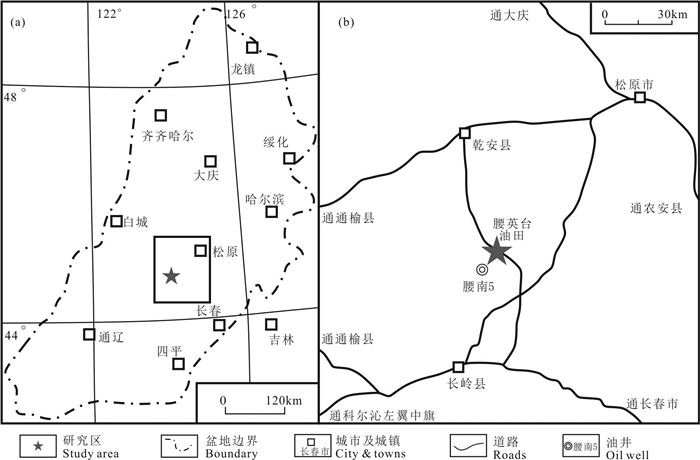
 下载:
下载:
